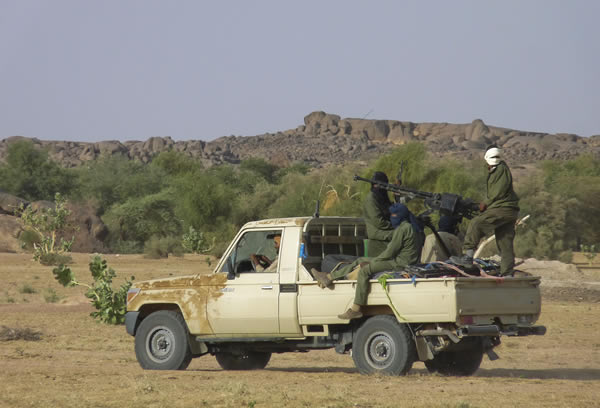
A file photograph dated October 18, 2011, shows Tuareg rebel fighters moving through northern Mali on a pick-up truck with a mounted heavy machine gun, near Kidal, Mali.
Last year, the fall of the Qadhafi regime spurred a domino-like effect across Africa’s Sahel region. When approximately 2,000 well-armed Tuareg rebels loyal to the former dictator left Libya and returned to Mali, they escalated the destabilization of the country’s north.
At the same time the Malian military, reportedly frustrated by the government’s inadequate resourcing for the fight against the northern rebels, overthrew the democratically elected president, Amadou Toumani Toure. Approximately two weeks later, a Tuareg rebel group known as the National Movement for the Liberation of Azawad (MNLA) declared Mali’s northern territory (referred to as Azawad) an independent state.
Complicating the situation is the spread of criminal gangs and extremist factions seeking to expand their influence throughout the region. These include:
- Ansar al- Din: an Islamist group that wants to impose Sharia law in Mali and is closely linked to the Algerian terrorist organization and al-Qaeda affiliate, al-Qaeda in Islamic Maghreb (AQIM).
- Al-Qaeda in the Islamic Maghreb (AQIM): al-Qaeda’s wing in northern Africa. Though based in Algeria, AQIM is seeking opportunities to expand across the North Africa and Sahel regions.
- National Movement for the Liberation of Azawad (MNLA): a Tuareg rebel group that seeks to liberate the northern towns of Gao, Kidal, and Timbuktu, known to them as Azawad.
- Jamaat Tawhid Wal Jihad Fi Garbi Ifriqiya (The Movement for Oneness and Jihad in West Africa, or MUJWA): a splinter group from AQIM that is active in Mauritania and known for conducting kidnappings.
- Boko Haram: a Nigerian extremist sect that seeks to establish an Islamist state in Nigeria. Boko Haram has links to both AQIM and al-Shabab in Somalia.
Despite regional governments’ longstanding concerns about the rise in Islamic extremism, the U.S. has provided relatively few resources to address the threat. Relying on the Trans-Sahara Counterterrorism Partnership (TSCTP), a multi-year initiative instituted under the Bush Administration, the U.S. seeks to build regional counterterrorism capacity. However, considering the enormity of the region (geographically, Mali is larger than Texas) and the limited authority national governments possess within their borders, the U.S is fighting an uphill battle.
In addition to the destabilization caused by the myriad of extremist groups, criminal gangs, and rebels, the Sahel is facing a major humanitarian crisis caused by widespread food shortages and the influx of people internally displaced by conflict. According to UNICEF, 1 million children in eight countries—Burkina Faso, Chad, Mali, Mauritania and Niger, Cameroon, Nigeria, and Senegal—are at risk of severe malnutrition. Furthermore, the crisis has caused at least 320,000 Malians to flee their homes. Of these, approximately 130,000 are believed to be internally displaced, while 190,000 have fled to neighboring Niger, Burkina Faso, Algeria, and Mauritania.
Solving this crisis will not be easy. Re-instituting a democratically elected government in Mali will take years, not months. The influx of extremist groups poses significant challenges not only to the region, but also for the United States and the international community.
Prudence Ukwishatse contributed to this blog post.


























